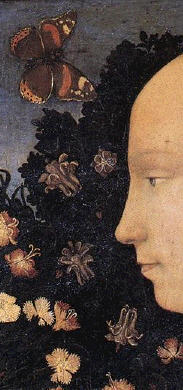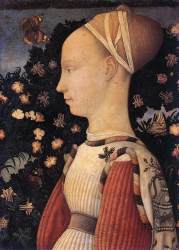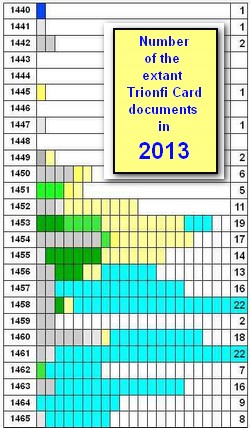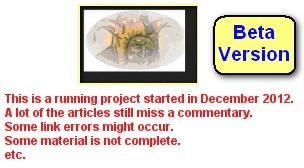Documentation: Old Summary of 2003
- based on Trionfi card documents available in 2003
composed by Lothar Teikemeier, last updated 06.12.2012
|
The following text Analyses of documents (1) - autumn 2003 presents our insights about the Tarot development at that time. In the meantime we've improved in discussions and with new information, which altered our earlier view. Start: Analyses of Documents (1) - autumn 2003 |
|
The theories about the origin of Tarot cards depend - beside the
existence of a few fragmentary playing card decks - on few documents
only. One sort of documents contains the appearance of the word "Trionfi" in context to playing cards. In the following we will discuss and demonstrate as good as possible in the moment these documents between the years 1442 and 1463. Main conclusions out of the following considerations:
A probability calculation, that this gap of "no entries" happened accidently, ends with a result from around 1 : 2000, which means, that it is highly unlikely, that this is an unsignificant, accidently sign of the process. It should be interpreted as a logical result of a specific unknown reality behind the entries, in this case it is likely, that there were in these years A. either not many Trionfi decks at the begin of the development, B. or that the name Trionfi was uncommon. In the case of B. there should be another name watchable, which looks as replaced. Such a name is not known, so it looks likely, that this feature must be interpreted as "there were not many Trionfi decks in the begin" (which is a logical feature of a begin; all products start to exist only in small number). However, the list of the 28 entries depends highly on the account books of Ferrara. Only 5 entries are notes outside of this city. These 5 entries are:
Generally: A thing has a good chance to be mentioned somewhere (in this case mostly letters), when it is new to many people. So the later (after 1452) missing of Trionfi-notes outside of Ferrara beside the "rapture in Bologna" is "naturally", Trionfi had left then the state of being a novelty. The entries from Ferrara one should exclude from this consideration, because there was a steady production of Trionfi and Trionfi-notes in Ferrara - cause the account books there reported simply expenses, a "novelty"-phenomen can't be observed by this. From the entries in Ferrara alone one should assume, that the interest in Trionfi is highest around the time of 1454, when a sort of Trionfi card manufacture existed at the Ferrarese court. In the political time this is parallel to the peace of Lodi 1454, which ended a periode of long wars and opened a longer phase of peace between the Italian cities, probably the Trionfi cards as a social phenomen helped to channel the aggressions in playing war only at the playing card table and not in reality. From this the hypothesis can be builded, that Trionfi decks are new to most people in Italy in this time 1449 - 1452. As the decks are noted already in 1442 the years between 1442 and 1449 must be evaluated as a time, when the decks either existed only in small number or were only reachable to a smaller cycle of people, either chosen by location or social group. The following graphic displays a view of the "peak of Ferrara-foreign events in the years 1449 - 1452" (red points), the continuous report of Ferrara (black points) with the "gap of entries in the years 1443 - 1448" and points to the great interest in the year 1454 (13 decks) by giving the number of decks we are talking of (lower line). Totally 44 decks are in the documents involved, three documents (M) speak of decks in a global manner, which points into the direction of mass production, 2 documents (R) in 1454 refer to special actions (no new decks involved). |
|
 On the basis of the above stated opinions one can take a near look at the documents, if something could be detected, which contradicts our main interpretations or something, which supports them. Naturally the Trionfi-notes outside of Ferrara are of special importance. 1449: Scipio Caraffa (appears in Marcellos letter, document 03 ) doesn't know the game (this suggests, that the type of deck type is new). Marcello himself already knows it and actually Marcello and Scipio first consider a deck, which is "too cheap for the hands of a queen" (the existence of this deck indicates an already existing mass production or production of decks with minor quality). Marcello is from Venetia/Padua, if one assumes, that the game spread from Ferrara (near Venetia), his acquaintaince with the new sort of deck is explainable. Marcello searches for manufacturers, who could produce a deck (it seems, he knows more than one, but it is unclear, if this are just manufacturers for playing cards, who could also produce Tarot cards, if necessary). New or not new ? This entry suggests, that there is already some acquaintance with the deck, but it might be a "local condition" (Venetia and Ferrara have a distance of ca. 80 km, if one assumes a small mass production in that region, it doesn't mean, that this form of new deck already reached Milano outside of the court - especially since there was war between Venetia and Milano and normal trade was handicaped). 1450: (Sforza, document 06 ): In Sforzas letter it seems, that the great duke with all his possibilities has obviously problems to get a simple Trionfi deck. He's in Lodi, when he writes the letter (somewhere on the country, 30 km from Milano), not in Milano. It seems, there is no deck on the country, but possibly in Milano. New or not new ? It seems clear: In Milano are not many Trionfi decks (however, there is the plague in Milano at that time and that might have caused the rarity, see below). 1450 (Florence): A statute allows Trionfi and some other games after the late 40ies seemed to have been a time of stronger card prohibition than before. A general theory about Florence and the rest of Italy assumes, that "in Florence all things were earlier than everywhere else, there was more creativity". A statute signals a broad stream of Trionfi cards - in Florence. But let's look precisely at the situation of 1449 - 1450: Nov. 1449: Marcello writes his letter. The political situation is very critical - all eyes watch Milano. Sforza tries to capture the city. There is famine in the city. Some thousand people will die soon cause of hunger, before Sforza is successful (Feb./March 1450). Venetia tries to intervene, but it doesn't work. Florence is happy after Sforza's victory (Cosimo de Medici had helped Sforza, now there is a new alliance possible, where 25 years had been more or less war between Florence-Milano). Short before Milano had a political experiment: trying to become a republic 3 long years, getting rid of a reigning duke in 1447 at the death of the unloved Filippo Maria Visconti. In the case the experiment would have had been successful, then Milano would have been the 3rd great republic of Italy beside Florence and Venetia. Under this condition other smaller cities would have thrown away their reigning nobility soon and the whole course of renaissance might have become rather revolutionary. This didn't happen, Sforza reestablished the dukedom in his own interests and reached a new, relatively peaceful balance between feudalism and republics. The anarchical state, that accompanies political changes, gave Sforza the opportunity to seize the power. In the year 1450 a plague reached Milano. 30 000 - 60 000 people (!) died in Milano. Probably that's the reason, why Sforza is not in Milano, but in Lodi. And the relatively chaotic conditions in the city: a. death of Fillipo Visconti in 1447, the funeral ended in a revolt b. 3 years Ambrosian republic c. with a 3/4 year siege + famine + victory of Sforza d with a plague with horrible much victims later in the year 1450 result in the condition: difficulties to get a Trionfi deck in Milano. The city is still a little chaotic in this year. The plague was not only regional, but I've no data, if Florence was involved. In times of the plague games had a great chance - see the Decamerone of Boccacchio. In Florence there is in the late 40ies strong "playing card prohibition". Perhaps with the success of Sforza in Milano the general context demanded "more liberal laws", so we have a release for players. Perhaps the plague and the play during the plague took an influence. And Florence is a place, where people reacted quickly: In 1377 Florence was the first city, that prohibited cards. New or not new? Trionfi might be new in Florence, although the statute signals: it is well known. 1452: Malatesta writes to the Sforzas, if he could have a connection to the trionfi producers in Cremona. This means: Malatesta - probably at that time in Rimini or in militaric mission in the region of Naples or Florence, far away (that's not totally sure) - invests considerable engagement to get such a deck. This he probably wouldn't do, if the Trionfi were reachable all and everywhere. Local condition in Rimini or Naples (in Florence Malatesta wouldn't have the problem, one should assume): no Trionfi deck reachable or at least no quality Trionfi deck reachable. Or Malatesta is a card gatherer, another possibility. Local condition in Milano: The Sforzas seem to have solved their card problem. New oder not new? This story tells, that Trionfi are relatively new, still. And now to Ferrara: although in the years 1450 - 1463 there is constantly something about Trionfi noted in Ferrara, there is NOTHING between 1442 - 1449. And the interest seems to develop slowly: 3 decks are produced in 1450 ( document 04 ) and one in 1451 ( document 07 ) and that's all before 1454, when Ferrara tried to start a mass production (in small dimensions, but the production of ). In concurrence to these documents appear in Ferrara also notes about the Imperatori deck, which disappears soon after the raising Trionfi success from Ferrara. Looking precisely at the first 2 entries from Ferrara 1442 (document 1 and 2): Document 01 starts optimistically with 4 Trionfi decks, Dokument 2 speaks of a deck for two boys, 9 and 11 years old. Additionally the document B points to a creative situation around 1st of January 1441, where the Trionfi deck idea might have been born. Conclusion out of these contexts: The very early Trionfi in Ferrara isn't taken serious by adult players and stayed as toys for younger humans. The court of Leonello (1442 - 1450) didn't show great interest, instead of this we see a greater interest for Imperatori decks in 1443 and after that no other document, which might indicate, that the courtly interest in playing cards generally was very weak between 1443 - 1450, that means till the death of Leonello. Looking precisely at all notes of Ferrara, we see a Parisina-phase between 1422 - 1424, a periode of nothing about playing cards after her death till 1434, and then a periode of playing card interests till 1443 with enough young persons in the right age at the court and then a pause again till 1450 - perhaps simply cause a desinterest of the regent Leonello in these years. In 1450 this changes, perhaps with Borso (although document 4 still happened under Leonello), but the Ferrarese documents do not reflect "Trionfi-enthusiasm", as one might read out of the Marcello-letter, the Florence-statute and the Sforza-letters. Perhaps one can interprete this as "less interested as elsewhere" at this time, and perhaps this refers to the condition that "around Ferrara the deck is NOT a novelty". A subground stream, not watchable to our eyes leads from the Ferrarese situation in 1442 to a situation in 1449/1450, where some trionfi decks exist, but this kind of play is not known everywhere and not existent in great number. A communication between Pier Candido Decembrio and Leonello after the death of Filippo Visconti (1447) about Decembrio's "Vita di Filippo Visconti" gives some further information about the state of Trionfi decks around that time, compare Ross Caldwells article at Document 28 (Polismagna) and the special article to the occurence. There are 6 (perhaps only 4) documents which give informations about the deck structure of Trionfi decks, 3 of them are fragments of playing card decks:
1 document and an insecure document suggest experiments with the number of 16 trumps. No document really suggests the existence of 22 trump cards. |
|
|
Repeated Note: When Ross Caldwell and me in 2003 started to collect Trionfi notes between 1442-1463, we had about 27/28 entries (which I nowadays would count as 31). The major part were the documents of Ferrara, which were collected by Gherardo Ortalli and Adriano Franceschini in the "Prince and the Playing Cards" (1996), after the base laying works of Michael Dummett and Stuart Kaplan around 1980. This collection included 2 notes about Trionfi cards in Florence, found by Franco Pratesi in his earlier work (allowances of the Trionfi game in 1450 and 1463). A graphical representation of this time (with 27 entries) shows the dominance of Ferrarese documents (in black) with a few notes only from other locations (in red; see picture to the right) In the period 2004 till October 2011 it was possible to add 4 further notes (Siena 1452, Padova 1455, Ancona c. 1460 and Valerio Marcello c. 1460), mainly thanks to information given by Thierry Depaulis. Franco Pratesi started his new article series in November 2011. Since then the list has gotten 67 new documents till September 2012 (65 of them found by Franco Pratesi, one, now the oldest of September 1440, by Thierry Depaulis, and another one by Veber Gulinelli, who controlled the earlier work of Franceschini and found an overlooked document) and nearly all are related to Florence or its surrounding. A small book (118 pages) was published around Christmas 2012, Franco Pratesi: "Playing Card Trade in 15th Century Florence" as IPCS Paper No. 7 (ISSN 0305-2133). It contains some of the articles, which before had appeared at this website, those, which treat the early time of 15th century. Thierry Depaulis commented in his foreword: "This book is a landmark in the history of early playing cards in Italy". Well, maybe not the book, but the research is clearly a landmark in various interests. For the collection of early Trionfi notes it somehow means, that we have within the year 2012 about 200 % more data for the period 1440-1462 than mankind had collected in the 200 years before. Added later: In August 2013 the new report of Arnold und Doris Esch: "Aus der Frühgeschichte der Spielkarte. Der Import von carte da giocare und trionfi nach Rom." in Gutenberg Jahrbuch 2013, 88. Jahrgang, p. 41-53, arrived in our redaction. It contains 106 new references to Trionfi decks, which all were found in the customs registers of the city Rome for the period 1453-1465. With this the number of all earlier Trionfi cards records has been doubled and should have reached then c. 210 (from which a few are only considered to be "Trionfi card notes" and don't contain the word "Trionfi" or something similar). *********** I'd started to sort the new Trionfi card documents overview in October 2012. Articles will be possibly changed according improvements in research. |
|




